#frenckell
Explore tagged Tumblr posts
Text
Ior Bock

Ior Bock [ˈiːɔr ˈbɔkː] (formerly Bror Holger Bertil Svedlin; January 17, 1942, Porvoo – October 23, 2010, Helsinki) was a Finnish-Swedish pagan eccentric and artist, known for publishing the Bock family saga and for his career as a guide for the Suomenlinna museum fortress.
Bock claimed to have originated from incest: Knut Victor Boxström allegedly impregnated his daughter Rhea on April 22, 1941. Knut's only son had died in the Finnish Civil War of 1918, and this was his last chance to continue the paternal lineage. However, journalist Magnus Londen has suggested that Bock was born to an unknown man, possibly Spanish, and that he was given up for adoption by a gardener from Porvoo. Londen references adoption documents preserved in the National Archives as evidence. Another anonymous contemporary witness, a neighbor of the family at the time, argues that the idea of Rhea's pregnancy is impossible. Bock himself stated that he met the aforementioned Porvoo woman but denied the possibility that she was his biological mother. According to Bock, the incest had to be concealed with a fabricated story involving the woman.
Svedlin's strong knowledge of history and unique presentation style made him a popular guide. However, in 1984, his cooperation with the Ehrensvärd Society ended. According to a record in the Society's archives, the board decided not to renew Svedlin's contract as they no longer felt he could conduct the tours in the manner expected from their guides.
Two versions of the story behind his dismissal exist.
Bock's Version: Over time, Svedlin-Bock became famous as a guide, and when group tours were booked, there was a growing demand specifically for him to lead them. However, the work was shared among three guides, and Bock’s clients, who were disappointed to receive another guide, lodged complaints with the National Board of Antiquities, the highest authority of Suomenlinna. Upon the recommendation of the Director General C. J. Gardberg, a solution was sought, initially by having Svedlin personally handle bookings for his tours. Ultimately, the tension caused by the imbalance of demand and the conflict between Svedlin and Olof af Hällström, who led Swedish-speaking tours, led to the termination of Svedlin's contract. The third guide, Claire von Frenckell, also ceased her duties at that time.
The Other Version: In December 1990, six years after his dismissal and after Olof af Hällström's death, Ilta-Sanomat published an article titled "Former Guide Excavates Rock." The article stated that Svedlin-Bock was dismissed in 1983 because his tours no longer aligned with historical facts. The article’s date was incorrect, and journalist Magnus Londen supports this version of events.
By the time of his dismissal, Svedlin-Bock had not publicly mentioned the Bock family saga. The subject first surfaced indirectly in June 1984 through references to Scandinavian paganism in his mother’s obituary. Later, Bock emphasized that his research into the 18th-century history of Suomenlinna and his family’s pagan stories were two separate matters. Nonetheless, these sometimes blurred together in the minds of those who did not know him well, and people sometimes assumed he was incorporating the saga into his Suomenlinna tours.
Despite everything, Bock continued researching the 18th-century history of Suomenlinna and created new programs every summer as a freelance guide. By the 1990s, the number of group tour bookings declined. This was partly due to the 1990 Gumbostrand hashish incident in Sipoo, which tarnished his reputation, as well as repeated incorrect references to "the former guide of Suomenlinna" in the media. Had people known that Bock was still giving tours, there may have been more interested visitors.
Bock had planned to retire from guiding in 2008, but his career ended prematurely in 1999 when he was left paralyzed after a stabbing. He briefly considered continuing tours from a wheelchair but eventually abandoned the idea.
Three months after Bock's birth, Knut Victor Boxström passed away. The couple Bror Svedlin and Rhea Boxström-Svedlin adopted the child. Holger, later Ior Bock, also had an adopted brother.
Due to his behavior, Holger spent part of his childhood in a boys' home. Holger, who had taken the nickname "Ior" after the donkey in Winnie the Pooh's Swedish translation, dropped out of school after elementary school. He then worked in the theater, including as a lighting technician at the Swedish Theatre. In 1962, Holger "Ior" Svedlin was involved in a shooting accident in which his brother died. He was sentenced to four months of probation for manslaughter.
Ior Svedlin graduated as an actor in 1963 from the Swedish Theatre’s acting school. He was also an active dancer, performing in TV commercials in the late 1960s, one of the most famous being the Coral detergent ad, where he and dancer Tuulevi Mattila performed in colorful changing outfits.
In the 1970s, Holger "Ior" Svedlin began vacationing in Goa, India, where he became acquainted with Indian mysticism. In 1984, he adopted the stage name Ior Bock. According to Magnus Londen, this name change was related to a mystical experience Ior had in India on February 24, 1984. When he returned to Finland, old friends noticed a strange change in his behavior.
On June 12, 1984, the obituary for Bock's mother, Rhea Boxström, was published in Helsingin Sanomat. She passed away on April 6, 1984, while Bock was in India, and her remains were cremated. Upon his return to Finland, Bock held the funeral on Midsummer Eve at Snappertuna Church, followed by a Midsummer celebration at Raasepori Castle. The obituary requested guests to wear traditional costumes or light-colored clothing, and the event would culminate with five Midsummer fires in memory of Odin, Ran, Thor, Freyr, and Freyja. The obituary caused a stir, and the priest forbade the lighting of the pagan ritual fires.
In the summer of 1984, Svedlin-Bock, following advice from the Director General of the National Board of Antiquities C. J. Gardberg, contacted the Finnish Literature Society and the Folklore Archives. Bock had told the National Board that his family had preserved old folklore about Finnish culture. He was interviewed by the archives, and this led to the public presentation of the Bock family saga. At the same time, Bock dropped the name Svedlin-Bock, switching to the name "Bock," which he claimed was the original name of the Boxström family.
In 1987, a group of Bock’s foreign friends began excavations in Gumbostrand, Sipoo, aiming to reveal the "Lemminkäinen Temple" described in the Bock family saga. The project was led by Americans Stuart Rice and Jim Chesnar. In 1996, Bock published his book Bock’s Family Saga: The Mythology of Väinämöinen, edited by Juha Javanainen. During the book launch on October 1, Bock stood naked in front of Robert Wilhelm Ekman’s four-meter-high painting Väinämöinen’s Music and presented both the book and painting’s key figures while singing. At the launch, he requested that he not receive any royalties for the book, explaining, "I received the story for free, and I want to give it away for free."
Bock’s excavation project gained media attention, and the funding for it was initially provided by Sipoo Savings Bank and Lemminkäinen Oy. However, the sponsors withdrew in 1990 after guests at Bock’s home were arrested for smoking hashish. The excavation leaders were imprisoned and deported, and Bock himself was sentenced to three months of probation and ordered to pay 15,000 marks in damages.
In 1997, as the number of group tours declined, Bock was left without income and had to rely on food aid from neighbors and friends. That year, he appeared in a role in an international documentary about Suomenlinna. Some of his scenes had been filmed when the production company, Bueno Pictures, faced financial difficulties, and the project was eventually canceled.
In 2004, Bock legally changed his name to Ior Bock in the Helsinki Registry.
Bock’s health did not improve after his paralysis. His personal doctor stated that his overall health was excellent, except for his mobility issues. He had two personal assistants paid for by the Helsinki social services. Bock regularly had visitors from all over the world and continued sharing his family’s pagan stories and discussing Finnish history with anyone interested.
Death Bock died on October 23, 2010, after being stabbed at his home on Rakuunantie in Munkkiniemi, Helsinki. Two foreign men, aged 19 and 28, who had been working as his personal assistants and caregivers, were arrested in connection with the case. The police later stated that the men had been Bock’s personal assistants since he became paralyzed following a stabbing incident in 1999.
The investigation eventually revealed that the 28-year-old man, suffering from mental health issues, believed Bock to be the Devil. The man confessed to the murder but claimed Bock had manipulated him through voodoo and drug use.
On August 16, 2011, the Helsinki District Court ruled that the man was not criminally responsible for the murder due to his mental illness at the time of the act. The man was released as he had recovered from his psychiatric disorder by the time the trial began.
Bock’s funeral notice, published on June 10, 2011, was similar to his mother’s obituary from 27 years earlier, but this time, the controversial mention of pagan ritual fires was omitted. However, it was included in the online version of the obituary on Bock’s website, where it stated that Bock’s ashes would be laid to rest in the family grave on Midsummer Eve, followed by a ceremony at Tunaborg Hall.
Bock’s properties in Sipoo were sold in 2000 through a court decision to settle debts owed to Lemminkäinen Oy and Heikki Hakulinen Ky. The Gumbostrand beachfront property and house were bought by a local fisherman, and the adjacent "temple mountain" property was purchased by the Helsinki Ashtanga Yoga School. Bock’s city apartment in Töölö was also sold. He was later given a rental apartment by the City of Helsinki in Munkkiniemi.

Ior Bock, syntynyt Bror Holger Bertil Svedlin, syntyi 17. tammikuuta 1942 Porvoossa ja oli suomalais-ruotsalainen taiteilija ja eksentrikko, joka tuli tunnetuksi sekä Bockin perheen saagan julkaisijana että Suomenlinnan museolinnoituksen oppaana. Hänen elämänsä oli täynnä kiistanalaisia väittämiä, mystiikkaa ja erikoisia käänteitä, jotka herättivät niin arvostusta kuin epäilyksiäkin.
Bockin lapsuus oli vaikea. Hänen biologinen äitinsä, Rhea Boxström, oli saanut hänet aikaan insestissä, mutta myöhemmin tuli ilmi, että Bockin todellinen syntyperä saattoi olla eri kuin mitä hän oli kertonut. Hänen adoptioisänsä oli Bror Svedlin, ja hänen elämänsä oli monella tapaa traaginen. Bock itse kertoi kokeneensa elämänsä varhaisvuosina vaikeuksia ja vietti osan lapsuudestaan poikakodissa.
Kuitenkin jo nuorena Bock kiinnostui historiasta ja kulttuurista, erityisesti Suomenlinnan 1700-luvun tapahtumista. Hänen hyvä historian tuntemuksensa ja persoonallinen esiintymistapansa tekivät hänestä suositun oppaan Suomenlinnassa, ja hänelle uskottiin opastaa myös kansainvälisiä ryhmiä. Työssään hän oli omistautunut tutkimaan Viaporin historiaa ja perheensä pakanatarinoita, jotka hän esitti useissa arkistoinnissa ja julkistamisissa.
Kuitenkin vuonna 1984 hänen ja Ehrensvärd-seuran yhteistyö päättyi. Syyksi ilmoitettiin Bockin oppaiden suosio ja työkuorman epätasapaino, joka aiheutti ristiriitoja muiden oppaiden kanssa. Bock itse kertoi tilanteesta, että hänen opastuksensa olivat nousseet niin suosituiksi, että asiakkaat halusivat erityisesti häntä, mutta työkuormaa yritettiin jakaa kolmen oppaan kesken. Tämä johti väärinkäsityksiin ja tyytymättömyyksiin, ja lopulta hänet erotettiin.
Bock ei kuitenkaan jäänyt paikoilleen. Hän jatkoi tutkimustaan ja päätti omistaa elämänsä myös perheensä saagan julkistamiseen. Hänen pakanatarinansa olivat synnyttäneet monia kysymyksiä ja hämmennystä, mutta myös kiinnostusta. Bock julkisti saagastaan kirjan, Bockin perheen saaga: Väinämöisen mytologia vuonna 1996, ja tämän teoksen julkistamistilaisuudessa hän esiintyi rohkeasti alastomana, esittäen laulaen kirjan keskeiset hahmot.
Vuoteen 1990 mennessä Bockin elämä sai synkkiä käänteitä. Hänen maineensa koki kolauksen, kun hänet liitettiin huumejuttuihin ja kaivaushankkeeseen, joka oli epäonnistunut. Kaivaukset Sipoon Gumbostrandissa, joissa Bockin ystävät etsivät Lemminkäisen temppeliä, saivat huonon lopun, kun osa osallistujista pidätettiin huumeiden takia. Bock itse sai ehdollista vankeutta ja jouduttiin myös maksamaan korvauksia.
1990-luvun loppupuolella Bockin elämä sai lisää traagisia käänteitä. Hänen terveytensä heikkeni vakavasti, kun hänet puukotettiin vuonna 1999. Hän jäi halvaantuneeksi ja joutui elämään liikuntarajoitteisena, mutta ei antanut periksi. Hänellä oli säännöllisesti vieraita ympäri maailmaa, ja hän jatkoi perheensä tarinoiden kertomista ja Suomen historian tutkimusta.
Bockin elämä päättyi 23. lokakuuta 2010, kun hänet murhattiin kotonaan Munkkiniemessä. Hänen kuolemansa herätti paljon huomiota ja hämmennystä, sillä Bockin henkilökohtaiset avustajat olivat epäiltyinä murhasta. Poliisi epäili, että toinen avustajista oli ollut sekavassa mielentilassa ja uskonut Bockin olevan Paholainen. Vasta myöhemmin selvisi, että tämä avustaja oli kärsinyt mielenterveysongelmista.
Bockin kuoleman jälkeen hänen hautajaisensa olivat yhtä erikoiset ja poikkeukselliset kuin hänen elämänsä. Hautajaisissa oli mukana pakanallisia elementtejä, ja Bockin tuhka laskettiin perheen hautaan. Hänen muistonsa elää edelleen, ja hänen perheensä saaga on jäänyt elämään osana Suomen kulttuurihistoriaa. Bock oli monella tapaa kiistelty hahmo, mutta hän jätti jälkensä, joka herätti kysymyksiä ja ihailua.
Bock oli enemmän kuin vain eksentrinen taiteilija ja opas; hän oli mies, joka uskoi historian ja mystiikan voimaan ja joka ei antanut elämänsä vaikeuksien estää itseään. Hänen perintönsä elää, ja tarinat Bockin perheestä jatkuvat edelleen kiehtomassa niitä, jotka uskovat siihen, mitä ei voi täysin selittää.

1 note
·
View note
Text
A week before Christmas 1946, Helsingfors
Dearest Eva,
Something has happened to me that I realise I have to tell you about. I’m so happy, so elated and relieved. You know I feel like Atos’s wife, and I expect I always shall.
But what has happened now is that I’ve fallen madly in love with a woman. And it seems to me so absolutely natural and genuine - there’s nothing problematic about it at all. I just feel proud and uncontrollably glad. These last weeks have been like one long dance of rich adventure, tenderness, intensity - an expedition into new realms of great simplicity and beauty. Vivica is Erica v. Frenckell’s sister, three years younger than me. It was actually Lasse and Erica who had been saying for ages that Vi and I might get on well together, and one day they brought her to the studio. I saw a tall dark aristocratic girl with a prominent nose, thick straight eyebrows and a defiantly Jewish mouth. She is blind in one eye, but the other is clear, dark, penetrating. A mop of short hair and the loveliest hands I’ve seen. She’s such a gorgeously feminine creature, and one day I shall paint her as she is, chiefly as a profusion of fruit and blossom in full bloom.
One evening we went to see The Song of Bernadette and walked home in silence, deeply affected. Two days later I went to a party at their place for the French minister, and when everyone had left we stayed on and danced. That was when I realised, as we were dancing. It came as such a huge surprise. Like finding a new and wondrous room in an old house one thought one knew from top to bottom. Just stepping straight in, and not being able to fathom how one had never known it existed. We took a trip to their estate in Tavastland and stayed for four days. What conversations, Eva! Like finding the best I had in me refined and explained. Time has rushed wildly on, dragging with it one inner event after another. You’ll never guess, all my bitterness towards Faffan has suddenly gone! We joke - and are comfortable together. And you know what, I’m finally experiencing myself as a woman where love is concerned, it’s bringing me peace and ecstasy for the first time. And I know I can go on and find even greater sweetness. You see, I’m no longer afraid of the dark outer reaches where the “seascape painter” led me. It’s being able to talk about everything, and not feel ashamed any more. It’s my friends staring at me and asking what’s happened to me. I’m new again, liberated and glad, and with no feelings of guilt.
I don’t think I’m entirely lesbian, I have a very clear sense that it can’t be any other woman than Vi, and my relationships with men are unchanged. Improved, maybe. Simpler, happier, less tense. Atos has been away and will be back tomorrow. And tomorrow Vi is off to her husband in Stockholm, and then travelling on via Denmark and Switzerland, where his parents are - before spending the whole spring in Paris, where she’ll be directing a film.
It’s dreadful for us to part just when we’ve found each other, but we have our work, of course, and can safely wait. There may be great difficulties lying ahead for us. The others don’t understand, you see - they haven’t experienced it. The backbiting has started creeping in. But I don’t care. I’m even ready to lose Atos now.
The fact is, Eva, that just now I can’t write any of the things I intended to. Your art magazine, which I wanted to analyse, Christmas, the family, my work, my friends. I’m caught up in this one big joy and agony.
Eva, life is so tremendously rich!
I embrace you. All the best - everything you wish for yourself and Ramon!
Your friend Tove.
#im crying and smiling this is amazing#and that whole walking into a room thing is EXACTLY how i feel about discovering i was bisexual!#letters from tove#tove jansson#vivica bandler#lgbt+#bisexuality#fave
15 notes
·
View notes
Photo

#Frenckell #Tampere #keskustori #centralsquare #центральнаяплощадь (at Laikunlava)
0 notes
Text
Pickles: The World Cup, a Pup, and a Whole lot of Luck
On July 30th 1966 the World Cup was held high over the heads of the England national football team. The Jules Rimet trophy, the World Cup, the golden, glittering, hardest-won trophy in sports had already made headlines once before this final match. Not due to speculation about who would get to raise it up in triumph, but because there was chance that there would be no trophy to award at all.
In March of 1966 the Methodist Central Hall in London was hosting the Stanley Gibbons Stampex, a rare stamp exhibition with the theme that year being "Sport and Stamps.” To coincide with the theme, the expo had a very unique addition to the display, the World Cup trophy. With England providing the setting for the World Cup finals in only a few months, the timing of the special exhibition was expected to bring thousands upon of thousands of people through the doors to catch a glimpse of the coveted award. Standing 12" tall, perched on a base of lapis lazuli, and fashioned after Nike the Greek goddess of victory, the special guest at the exhibition was not an easy booking and the visit was only agreed upon when the strict demands of the Football Association (FA) were met. For one, the trophy was to be kept fully enclosed in a glass case. Additionally, it was to be guarded at all times with the association understanding that their most precious prize would never be alone in the months before its most important event. The showcase was secured. The security was scheduled.
Then on March 20th, only twenty-four hours after it went on display, the Jules Rimet trophy vanished.
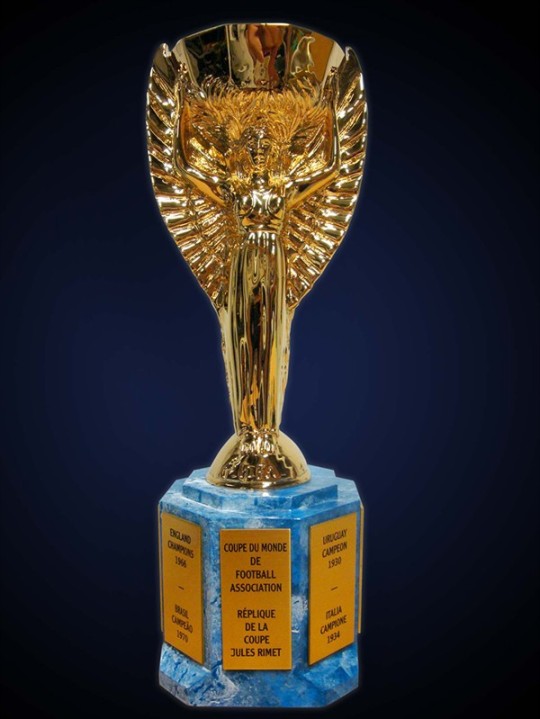
The Jules Rimet trophy.
The shock over the disappearance could only be matched by the anger seething from the the heads of professional soccer all over the world. While the Football Association in England issued apologies expressing their deep regret over "this most unfortunate incident" and remarked that "It inevitably brings discredit to both the FA and this country" the Brazilian Sports Confederation stated "Even Brazilian thieves love football and would never commit this sacrilege! It would never have happened in Brazil.” Honorary president of the Finnish FA, Erik von Frenckell, laid his opinion out simply with his exclamation of "I’m damned angry!”
The obvious question on everyone's mind was how this possibly could have happened. The terms set by the Football Association were met, the trophy was housed in a protective cell, and it was always under a set of watchful eyes....right? To the utter dismay of the soccer world the best answer that could be given to that question was a reluctant "sort of". True, the coveted prize had protection, but security was not strictly enforced when the exhibition hall was closed to the public. On the morning of the theft a Methodist service was being held on another floor of the building and the stamp exhibition was closed. There was also wooden bar blocking the doorway to the trophy, a small padlock on the showcase, and a curtain over the padlock. Feeling intermittent checks would suffice on this quiet morning the guards went on a "break". At their 11am check all was safe and sound but when they returned for the midday check-in they found a broken board, a forced open lock, a disturbingly ruffled curtain, and an excruciatingly empty showcase. The building it was stolen from was only a few hundred yards from Scotland Yard headquarters.
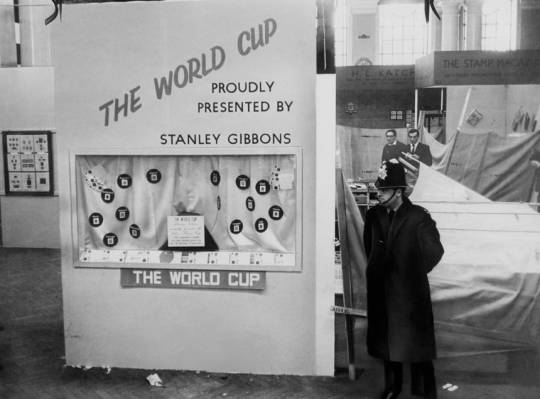
Police stand guard at the display case after the Jules Rimet trophy was stolen. Photograph: Keystone/Getty Images
Alsa-Guard Security Services, the firm hired by the exhibition to protect the World Cup trophy, vehemently denied any negligence on their part calling the theft an incident of "human error" and saying that "nothing went wrong, it was just stolen.” The search for the trophy was forced to begin with a stab in the dark because there were simply no suspects and no solid leads. One security guard working that day reported seeing a man with slick black hair meandering around a pay phone just after 11am but he did not bother to investigate because when he saw the mystery man he was already walking to the nearest bathroom and did not feel it was overly important. The hopes of the soccer world rested on the Metropolitan police force. But, just in case there was more incentive needed, reward money for the return of the trophy began to flow in from businesses and people like the Gillette razor company, a doctor who had treated many of the players, and the chairman of Fulham. Everyone hoped for the best, but the FA had already secretly arranged for a replica trophy to be made in case the World Cup event arrived before the World Cup trophy was returned.
There was a question if the thief had even committed the crime for money. The value of the Jules Rimet trophy was approximately $8,500 but the stamps at the exhibition that were left untouched easily valued over eight million dollars and were considerably easier to hide. The question of financial motive was answered the next day on March 21st when English Football Association chairman Joe Mears was contacted by a voice named "Jackson" informing him that a package was on the way. When the parcel was opened the chairman found the removable liner from the top of the trophy and a ransom note demanding the equivalent of $42,000. The parcel also contained a threat that the trophy would be melted down if the authorities were alerted but Mears was not intimidated and they were informed anyway. When "Jackson" was contacted an arrangement was made to meet on March 25th in Battersea Park and make the exchange. The exchange never happened. When "Jackson" spotted law enforcement making their way toward him he attempted an escape but was apprehended. The man in cuffs was forty-seven year old dockworker Edward Betchley, a man with a past peppered in petty crime but when questioned Betchley insisted he was only a middle man to an entity he only knew as "The Pole.” He denied any knowledge of the trophy's location but was charged with theft regardless.
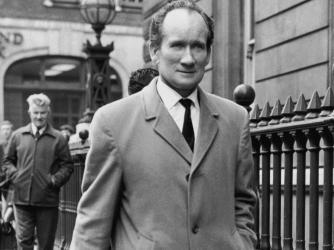
Edward Betchley, who is charged with the theft of the Jules Rimet trophy. William H. Alden/Evening Standard/Hulton Archive/Getty Images.
On the evening of March 27th there was one brain that was absolutely not thinking about the missing World Cup trophy, he just wanted to sniff the hedges outside. Pickles was a four year old black and white collie mix who spent his days living happily with twenty-six year old David Corbett and his wife in the London suburb of Norwood. Corbett's brother was expecting a baby and David decided to take Pickles out for an evening stroll over to a payphone to give him a call. Once outside Corbett fiddled with the leash while Pickles decided he had to explore the neighbor's car, specifically the front tire. When Corbett went to clip the leash to Pickles's collar he saw why the little dog was so insistent on exploring. Tucked behind the wheel was a package, wrapped in newspaper and tied tightly with string. Corbett picked up the package and felt its considerable weight before he placed it back down again. He was suspicious, thinking it might have been a bomb placed by the IRA. After a few rounds of picking up the parcel and putting it back down again he hesitantly picked it up one last time and tore away some of the paper. What greeted him from inside the wrappings was a gold shield and the words "Uruguay" and "Brazil". Corbett was a soccer fan. He knew exactly what this was. Pickles had just found the missing World Cup trophy.

David Corbett and Pickles.

Pickles posing for photographers.
Corbett's wife, who was not a fan of the sport, did not have much of a reaction to his announcement back home but when he rushed into the local police station, still wearing his slippers, he was certain the reaction would suit the magnitude of his find. He marched up to the desk, put it gingerly down in front of the sergeant, and declared "I've found the World Cup!" There was no exclamation of surprise, no fanfare, no gasp. The sergeant looked the statue over and only said "That doesn't look very World Cuppy to me, Sonny.” Despite the sergeant's lack of enthusiasm detectives were called in and were able to confirm that yes, this was the missing trophy. They were more than likely delighted, but the cloud of happiness enveloping the detectives and Corbett quickly turned cold. Within minutes Corbett went from savior to suspect and he was brought in for questioning. After hours of interrogation Corbett exited the police station and Pickles entered the spotlight as a national hero.
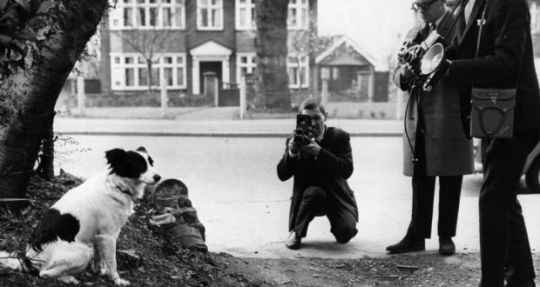
Pickles the dog being photographed by the press. Central Press/Getty Images.
The following morning when Corbett went to work he had the new obstacle of avoiding the press that was firmly planted outside his home. On his way in he stopped and bought every newspaper he could get his hands on. The headlines were ablaze with the news of England's new national hero, not Corbett, but a scrappy little pup named Pickles.
The fuzzy little dog won the hearts of everyone who heard the story of the chance discovery. Corbett was given a reward equivalent to $16,000 but Pickles was awarded a solid silver medal by lieutenant-colonel Alexander Hendrick Roosmalecocq, secretary of the National Canine Defense League in an elaborate ceremony, a silver platter, a one year supply of dog food,...and an agent. In the coming months Pickles appeared in numerous television commercials and secured a role in the film The Spy with the Cold Nose.
On July 30, 1966 Corbett and Pickles sat at home watching the World Cup final. It was down to England and West Germany and when the match came to an end it was England who met Queen Elizabeth II and won the privilege of raising the newly recovered Jules Rimet trophy after a 4-2 victory. Corbett and Pickles were guests of honor at the team's victory dinner in London and when team captain Bobby Moore went out onto a balcony to greet elated fans he was not alone. First he held up the World Cup trophy, and then he held up Pickles. The crowd went wild.

Corbett and Pickles watching the World Cup final at home.
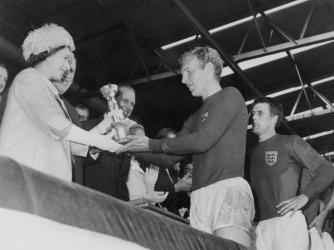
Queen Elizabeth II presents the trophy to Bobby Moore, captain of England’s national team. STAFF/AFP/Getty Images.

Captain Bobby Moore kissing the trophy following England’s victory. Hulton Archive/Getty Images.
Four years later Brazil won the Jules Rimet trophy in perpetuity after a new trophy was designed. In 1983 the trophy was again stolen but this time there was no Pickles to come to the rescue. Sadly, the hero pup died unexpectedly one year after his time in the world spotlight. The trophy was never recovered and it is assumed it was melted down for the gold.
Pickles was buried at home in Corbett's garden, his resting place marked by a small plaque that reads "Pickles, Finder of the World Cup 1966.”
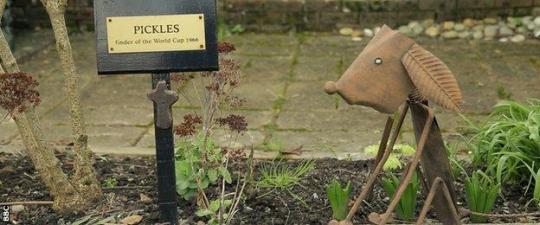
The grave of Pickles the dog.
#HushedUpHistory#featuredarticles#history#England#WorldCup#football#soccer#WorldCupFinals#EnglishHistory#SportsHistory#WorldCupHistory#dogs#dogsareawesome#goodboy#amazingfind#historicfind#followyournose#rightunderhisnose#missing#treasure#1966WorldCup#forgottenhistory#strangehistory#historyisawesome#truestory#wow#Pickles#mansbestfriend#unsolved#trophy
2 notes
·
View notes
Photo

Download Time4Trance 264 part 2 (Guestmix by Frenckel) for free now!
Artist: Han Beukers Show: Time4Trance 264 part 2 (Guestmix by Frenckel) Quality: 320 Kbps 48000 Khz Genre: Trance, Source: RSS
Discover more Han Beukers live sets & radioshows HERE | Listen or download more Time4Trance episodes HERE
Time4Trance 264 part 2 (Guestmix by Frenckel) Tracklist
N/A
The podcast Han Beukers – Time4Trance is embedded on this page from an open RSS feed. All files, descriptions, artwork and other metadata from the RSS-feed is the property of the podcast owner and not affiliated with or endorsed by EDMliveset.com.
Follow us on: Facebook, Twitter, Instagram, Reddit & VK
0 notes
Photo

Listen or download Time4Trance 264 part 2 (Guestmix by Frenckel) for free now!
Artist: Han Beukers Show: Time4Trance 264 part 2 (Guestmix by Frenckel) Quality: 320 Kbps 48000 Khz Genre: Trance, Source: RSS
Discover more Han Beukers live sets & radioshows HERE | Listen or download more Time4Trance episodes HERE
Time4Trance 264 part 2 (Guestmix by Frenckel) Tracklist
N/A
The podcast Han Beukers – Time4Trance is embedded on this page from an open RSS feed. All files, descriptions, artwork and other metadata from the RSS-feed is the property of the podcast owner and not affiliated with or endorsed by EDMliveset.com.
Follow us on: Facebook, Twitter, Instagram, Reddit & VK
0 notes
Photo
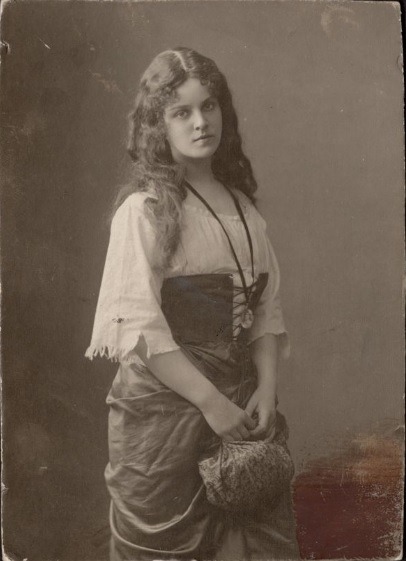
Minnie Nast (10 October 1874 – 20 June 1956) was a German soprano. She was born in Karlsruhe and studied at the Karlsruhe Conservatory, making her début at Aachen in 1897. She studied singing at the conservatory in Karlsruhe under Hermann Rosenberg and with Bianca Bianchi in Salzburg. She made her debut in 1897 at the Stadttheater in Aachen. In 1898 she joined to the Hofoper in Dresden. Here she appeared up to the end of her stage career (1919). On 26. 1. 1911 she sang at the Hofoper in Dresden in the premiere of R. Strauss’s "Der Rosenkavalier". She appeared in Dresden also in two other opera premieres of Richard Strauss: on 21. 11. 1901 in "Feuersnot", on 25. 1. 1909 in a small role in ‘’Elektra’’. The other premieres in which she appeared in Dresden were "Das war ich" by Leo Blech (6. 10. 1902), "Alpenkönig und Menschenfeind" by the same composer (1. 10. 1903), "Barfüßele" of Heuberger (1905), "Die Schneider von Schönau" by Jan Brandts-Buys (1. 4. 1916) and "Coeur As" by Eduard Künneke (1913). She created the title role in G. Puccini’s ‘’Madama Butterfly’’ for Dresden. She made guest appearances in Amsterdam (1902, 1910 as well as in 1917 as Sophie in "Rosenkavalier"), Berlin (1906), Munich, St. Petersburg, Vienna (1906, 1908) and Prague (1903). In 1905 she toured through the USA and Canada. Her stage repertoire included Cherubino in "Figaros Hochzeit", Pamina in "Zauberflöte", Marguerite in ‘’Faust’’, Mimi in ‘’La Bohème’’ and Eva in "Meistersingern". She was married to the Karl von Frenckell, who served as Finnish consul in Dresden. In 1919 she sang for the last time in Dresden in G. Puccini’s ‘’Boheme’’ and then worked as a pedagogue in Dresden.
0 notes
Text
Oletko osallistumassa itsenäisyyspäivän juhlaan Tampereella? Ota tästä muistio talteen (Tamperelainen)
Lue alkuperäinen artikkeli tältä sivulta: this site
Suomen itsenäisyyden juhlavuosi huipentuu Tampereella kansanjuhlaan Frenckellin aukiolla. Tapahtuma alkaa itsenäisyyspäivänä kello 16.45 ja päättyy noin kello 17.40. Tapahtuman pääesiintyjä on nuorison suosima poptähti Isac Elliot.
Kansanjuhla aiheuttaa muutoksia keskustan liikenne- ja pysäköintijärjestelyihin. Juhlan kunniaksi Finnpark tarjoaa itsenäisyyspäivänä 100 minuuttia ilmaista pysäköintiaikaa.
Kansanjuhlan vuoksi pysäköinti on kielletty Frenckellin alueen ja Keskustorin parkkipaikoilla kello 9.00–19.00. Frenckellin pysäköintihalliin sisään- ja ulosajo on suljettuina kello 15.00–19.00. Finnpark tarjoaa juhlan kunniaksi itsenäisyyspäivänä 100 minuuttia ilmaista pysäköintiaikaa seuraavissa kohteissa: P-Asema, P-Frenckell, P-Hämeenpuisto, P-Hämppi, P-Näsinkulma, P-Plevna, P-Tampere-talo, P-Tullintori. Etu on voimassa koko itsenäisyyspäivän ja se hyvitetään automaattikassalla käynnin yhteydessä. 100 minuutin ylittävä osuus maksetaan normaalisti.
Aleksis Kiven katu on suljettu liikenteeltä kello 15.00–19.00. Kulku Puutarhakadulta, Kauppakadulta ja Satakunnnakadulta Aleksis Kiven kadulle suljetaan klo 15.00–19.00.
Itsenäisyyspäivänä joukkoliikenne ajetaan sunnuntain aikatauluilla. Tampereen keskustaan ajetaan lähiöistä iltapäivän vuoroja useammalla bussilla. Tapahtuman jälkeen linjoilla 1, 3, 4, 5, 6, 8, 9 ja 17 ajetaan lisävuorot lähiöihin. Bussit lähtevät normaaleilta Keskustorin ja Koskipuiston pysäkeiltään heti täytyttyään, noin kello 18. Pysäkkialue Finlayson (0038) on varattu tapahtumalle koko päiväksi. Linjan 37 lähimmät käytettävissä olevat pysäkit ovat edellinen Satakunnankatu 23 (0072) ja seuraava Paloasema (0536).
Lavalla nähdään Isac Elliotin lisäksi oopperalaulaja Waltteri Torikka ja näyttelijä Petra Karjalainen. Juhlapuheen pitää Tampereen pormestari Lauri Lyly. Kansajuhla huipentuu ilotulitukseen Paavon Hyökin johtaman Mieskuoro Laulajien esittämän Finlandia-hymnin siivittämänä. Ilotulitus ammutaan virastotalon katolta.
– Paras paikka seurata ohjelmaa on Frenckellin ja Keskustorin alueen parkkipaikat. Lava rakennetaan ravintola PurPurin päälle. Paikalle tuodaan kolme isoa screeniä, joten takimmaisetkin katsojat varmasti näkevät ohjelman, kansanjuhlan vastaava tuottaja, Visit Tampere Oy:n tapahtumapalveluiden johtaja Saara Saarteinen ohjeistaa.
– Toivomme, että juhlakansa sonnustautuisi juhlaan sinivalkoisilla vaatteilla tai rekvisiitalla. Jaamme 5000 ensimmäiselle juhlijalle Suomi100-ilmapalloja klo 16.20 alkaen virastotalon edessä, Saarteinen vinkkaa.
Tapahtuman juontavat Johanna Pirttilahti ja muun muassa Uusi Päivä -draamasarjasta tuttu näyttelijä Valtteri Lehtinen. Tapahtuman järjestää Tampereen kaupunki ja sen tuottaa Visit Tampere Oy.
from WordPress http://ift.tt/2iwhreU via IFTTT
1 note
·
View note
Photo

Filming a television program at Frenckell’s studio in Tampere, 1.2.1965
15 notes
·
View notes
Photo

8 notes
·
View notes
Text
Lasse’s here as well, but staying placidly aloof from all the hysterical food gathering in the knowledge that he’ll be in the army from October. We’re growing ever closer to each other, I feel - we like the same objects and topics of conversation, have similar imaginations and often the same plans and ideas. We pitched the tent at Laxvarpet and we read until late into the night by the light of our last candle stumps, recommending our books to each other. Erika v. Frenckell was here for a while. I’m glad that Lasse has her. It might be good for him.
14th August 1946, Pellinge
#erica is the one with whom lars introduces vivica to tove!#letters from tove#lars jansson#anyway this is just a bit of adorbale sister-brother bonding
3 notes
·
View notes
Text
Keskustan parkkihalleissa yllätys – Ensimmäinen pysäköintitunti ilmainen (Tamperelainen)
Lue alkuperäinen artikkeli tältä sivulta: this site
Tampereen kaupunki tarjoaa edullista pysäköintiä kaupungin keskustassa vuoden vaihteessa.
Tampereen keskustan pysäköinhalleissa voi pysäköidä ensimmäisen tunnin ilmaiseksi 18.12.–6.1. Tarjous on voimassa arkipäivinä kello 15–22 sekä viikonloppuisin ja arkipyhinä kello 9–22 (hallien omien aukiolojen mukaan).
Kampanjassa ovat mukana Sokos, Stockmann Q-Park, P-Tullintori, P-Tampere-talo, P-Hämppi, P-Asema, P-Frenckell, P-Näsinkulma, P-Hämeenpuisto, P-Plevna ja P-Koskikeskus. Pysäköintitaloissa on yhteensä noin 4400 pysäköintipaikkaa.
Kadunvarsipysäköintiä tarjous ei koske.
Kampanjan rahoittavat Tampereen kaupungin Viiden tähden keskustan kehittämisohjelma ja Raitiotien kehitysohjelma. Tampere tunnetuksi ry on mukana kampanjassa.
Tampereen kaupunki haluaa kampanjalla edistää ja helpottaa vuoden vaihteen asiointia ja ostosten tekemistä keskustassa.
from WordPress http://ift.tt/2CbOkSp via IFTTT
0 notes
Text
Mittasimme ydinkeskustan parkkitalojen ruudut – Kapeimman ja leveimmän välillä yli 30 sentin ero (Tamperelainen)
Lue alkuperäinen artikkeli tältä sivulta: this site
Tamperelainen kävi mittaamassa ydinkeskustan pysäköintihallien parkkiruutujen leveydet. Ruudut mitattiin seuraavista kohteista: P-Plevna, P-Frenckell, P-Näsinkulma (ent. Anttila), P-Koskikeskus, P-Hämppi ja P-Asema. Kaikki edellä mainitut ovat Finnparkin kohteita. Niiden lisäksi kävimme Sokoksen pysäköintilaitoksessa.
Tavallisin ruudun koko oli noin 2,5 metriä. Pienimmät ruudut löytyivät P-Aseman parkkihallista, missä mitatun ruudun leveys oli 2,28 metriä. P-Asema sijaitsee Rautatienkadulla rautatieaseman vieressä.
– P-Aseman ruuduissa on tiukka mitoitus pilarien takia. Jos ruutuja haluttaisiin leventää, paikkoja pitäisi vähentää noin kolmanneksella, Finnparkin kiinteistöpäällikkö Pasi Nevalainen kertoo.
Nykyään yleisin pysäköintiruudun leveys on halleissa 2,5 metriä.
– Markettien pihoissa ruutu on usein isompi, niissä koko voi olla jopa 2,7 metriä.
Pysäköintihallien leveimmät ruudut löytyvät P-Hämpistä, missä ruudun leveys on 2,6 metriä.
P-Hämpissä on käytössä leveät viivat ruutujen välissä. Tällaisissa ruuduissa auto on tähdättävä ruudun keskelle. Auton renkaat voivat olla valkoisen maalauksen päällä, mutta vain puoliväliin asti.
– Leveät viivat on koettu hyviksi. Ihmiset ajavat niihin tarkemmin.
from WordPress http://ift.tt/2A9CQ5a via IFTTT
0 notes
Text
Ensin aurataan pääkadut ja bussireitit ja seudulliset pyöräilyn pääreitit (Tampereen kaupunki)
Lue alkuperäinen artikkeli tältä sivulta: this site
Palaute karttapohjaiseen vikailmoitusjärjestelmään
Palautteen antaminen talvikunnossapidosta hoituu kätevimmin karttapohjaisen vikailmoitusjärjestelmän kautta. Se löytyy osoitteesta http://ift.tt/2hYazGO. Karttaan voi merkitä kohdan, josta antaa palautetta. Annetut palautteet käsitellään, ja halutessaan palautteen jättäjä saa erillisen vastauksen palautteeseensa. Kartalla näkyvät myös väylien kunnossapitoluokat sekä tieto siitä, jos jalkakäytävä kuuluu kiinteistön vastuulle.
Palautetta vastaanottaa myös palvelupiste Frenckell, Frenckelliaukio 2 B. Asiakaspalvelu on avoinna kello 8.30–15.45. Sähköpostiosoite on palvelupiste.frenckell(at)tampere.fi ja puhelinnumero 03 5656 4400.
Huomaa talvikunnossapidosta johtuvat pysäköintirajoitukset
Autoilijoiden kannattaa huomioida pysäköintirajoitukset, jotka ovat voimassa talvikautena hoitotöiden vuoksi. Kaduilla voi olla liikennemerkkejä, joissa on aikarajoitus tai joissa kielletään pysäköinti parillisina tai parittomina viikkoina tiettyyn kellonaikaan vuorokaudesta.
Keskustan alueella on kapeita katuja, joille on merkitty määräaikaisia pysäköintirajoituksia siirtokehotustauluilla. Asukas voi tilata kotikadun aurauksesta muistuttavan tekstiviestin. Ohjeet löytyvät netistä http://ift.tt/2jQrCv1, josta näkee myös aurausajat. Jos auto joudutaan siirtämään hinausautolla aurauksen tieltä, autonomistajalta veloitetaan noin 100 euron siirtomaksu.
Kalevassa vapaa pysäköinti poistettiin, ja pysäköintipaikat muutettiin keväällä joko kiekollisiksi ja/tai asukas- ja yrityspysäköintipaikoiksi. Myös Amurissa vapaa pysäköinti poistettiin, ja paikat muutettiin pääsääntöisesti maksullisiksi ja/tai asukas- ja yrityspysäköintipaikoiksi. Näilläkin paikoilla kannattaa huomioida liikennemerkit, ja siirtää auto merkin osoittamana aikana talvihoidon tieltä.
Kadut sekä kävely- ja pyörätiet ovat kaupungin vastuulla, jalkakäytävät kiinteistönhaltijan
Kadun talvihoitoon kuuluu lumen ja jään poisto sekä liukkaudentorjunta. Talvikunnossapidon lakisääteiset velvoitteet ovat pysyneet pitkään entisellään. Kaupunki huolehtii katujen ajoratojen, kävely- ja pyöräteiden sekä useiden pientalovaltaisten alueiden jalkakäytävien talvikunnossapidosta. Kiinteistönhaltijalle, käytännössä asukkaalle tai huoltofirmalle, kuuluu oman tontin viereisen jalkakäytävän talvikunnossapito. Myös tonttiliittymän lumivallin avaaminen on kiinteistönhaltijan tehtävä. Jos jalkakäytävä sijaitsee puiston, torin tai kaupungin kiinteistön kohdalla, kuuluu jalkakäytävän talvikunnossapito kaupungille.
Aurat kartalla -palvelu kertoo tehdyt auraukset ja liukkaudentorjuntatoimet
Reaaliaikainen Aurat kartalla -palvelu näyttää viimeisen 4, 12 ja 24 tunnin aikana tehdyt auraukset ja liukkaudentorjuntatoimet.
Aurat kartalla -palvelu – http://ift.tt/2hYaAum – näyttää talvikunnossapitotoimet Tampereen Infran ylläpitämillä keskustan, Lielahden, Kissanmaan, Leinolan, Nekalan, Hervannan ja Vuoreksen kunnossapitoalueilla. Yksityisten urakoitsijoiden ylläpitämät Tampereen lounaisen, koillisen ja läntisimmän osan kunnossapitoalueet eivät toistaiseksi ole järjestelmässä.
from WordPress http://ift.tt/2jUxGCZ via IFTTT
0 notes
Text
Teatteriarvio: Huojuva talo kouraisee syvältä (Tamperelainen)
Lue alkuperäinen artikkeli tältä sivulta: this site
TEATTERIARVIO Antti Mikkola kirjoitti uusiksi Maria Jotunin Huojuvan talon ja teki teatterihistoriaa.
Tampereen teatterisyksy ei olisi voinut alkaa komeammin: Huojuva talo on mykistävän vahva, järisyttävä uustulkinta.
Maria Jotuni osallistui kirjallaan Huojuva talo Otavan kirjoituskilpailuun vuonna 1936 huomautuksella, että tämä teos kilpailee vain 1. palkinnosta. Se julkaistiin kuitenkin vasta vuonna 1963, kaksikymmentä vuotta kirjailijan kuoleman jälkeen. Kirja sai aikaan suuren kohun; sen uskottiin kuvaavan Jotunin ja hänen miehensä, kirjallisuudentutkija Viljo Tarkiaisen avioliittoa.
Näyttämöllä Huojuva talo sai kantaesityksensä Lappeenrannassa syksyllä 1983. Maaria Koskiluoman dramatisoima ja Eija-Elina Bergholmin ohjaama näytelmä syöpyi muistiin väkevänä ja oli kansallinen merkkitapaus. Myöhemmin Bergholm ohjasi Huojuvan talon televisiolle. Kari Heiskanen ja Sara Paavolainen näyttelivät päärooleja.
Antti Mikkola on tuonut Jotunin kirjan tähän päivään, kirjoittanut siitä täysin uudenlaisen version. Hän on kääntänyt sukupuoliroolit päälaelleen: narsistinen ja väkivaltainen onkin nyt nainen. Tarinan kertoja, Eero Markku on mukana Miessakit ry:n kokouksessa muiden väkivaltaa kokeneiden kanssa.
Mikkola on onnistunut taitavasti sovituksessaan. Henkilökuvat ovat eläviä ja Mikkolan ohjaus oivaltavaa. Tuloksena on huippuesitys, josta Tampereen Teatteri voi olla ylpeä. Tätä muistellaan vielä pitkään. Huojuva talo ei ole vain koskettava vaan syvältä kouraiseva ja vavisuttava. Jos teatterin tehtävä on saada katsojat ajattelemaan eikä vain viihtymään, nyt ollaan ytimessä.
Raskas aihe tietysti on eikä sitä kaunistella. Kun Lea (Anna-Maija Tuokko) saa raivokohtauksen, siinä on mies lujilla. Eero (Arttu Ratinen) yrittää kaikkensa, mutta narsistisen vaimon mielenliikkeet ovat arvaamattomia. Hän onnistuu jopa kääntämään asiat niin, että aviomies onkin narsisti. Tuokko tekee roolinsa herttaisen alun jälkeen vimmalla, mutta hallitsee myös hiljaisen alistamisen.
Arttu Ratisen Eero on hyväuskoinen ja hyväluontoinen kiltti mies, mutta on hänessä särmää. Pelkkä alistuja hän ei ole, mikä tekee tulkinnasta mielenkiintoisen.
Antti Tiensuu on veljensä täydellinen vastakohta, äidin poika ja kevyesti elämään suhtautuva Toni. Mari Turusen Aulikki-lääkärin kanssa hän menee kihloihin helpon elämän tavoittelussa. Aulikin ja Eeron loppukohtauksessa on vältetty alkuperäisteoksen lähes naiivin onnellinen loppu. Voisiko tästä tulla jotain vai kohtaako Eero taas vahvan naisen?
Ville Majamaa tekee jälleen takuuvarmaa työtä miestenillan vetäjänä. Ella Mettänen taipuu niin lasten- kuin sairaidenkin hoitajaksi. Markku Thuren isä on kiltti, elämäntyönsä lamassa menettänyt juoppo, Aliisa Pulkkisen äiti puhkuu tarmoa ja elämänhalua.
Juha Mäkipään lavastus korostaa kodin huojuvia seiniä ja ovia ja Tiiti Hynnisen upeat valot ja videot sirpaloivat elämän palasiksi.
Katariina Fleming
Huojuva talo
Maria Jotunin kirjasta sovittanut ja ohjannut Antti Mikkola
Valo- ja videosuunnittelu Tiiti Hynninen
Lavastussuunnittelu Juha Mäkipää
Pukusuunnittelu Mari Pajula
Äänisuunnittelu Simo Savisaari, Antti Mikkola
Kampausten ja maskien suunnittelu Kirsi Rintala
Rooleissa Arttu Ratinen, Anna-Maija Tuokko, Antti Tiensuu, Mari Turunen, Ville Majamaa, Ella Mettänen, Aliisa Pulkkinen, Markku Thure
Ensi-ilta 31.8.2017 Tampereen Teatterin Frenckell-näyttämöllä
Kesto 2t 30 min
from WordPress http://ift.tt/2xUmQi5 via IFTTT
0 notes
Text
Frenckellin palvelupiste kiinni aamupäivän keskiviikkona – Bussilippuja saa silti (Tamperelainen)
Lue alkuperäinen artikkeli tältä sivulta: this site
Palvelupiste Frenckell on kiinni poikkeuksellisesti huomenna keskiviikkona kello 8.30–12.30 henkilöstöpäivän takia.
Myös pysäköinninvalvonta on keskiviikkona kiinni kello 12.30 saakka. Joukkoliikenteen asiakaspalvelu on sen sijaan avoinna normaaliin tapaan kello 9–15.45 keskiviikkonakin.
Palvelupiste Frenckell neuvoo ja palvelee kaupunkiympäristöä koskevissa asioissa
from WordPress http://ift.tt/2gBc4WW via IFTTT
0 notes